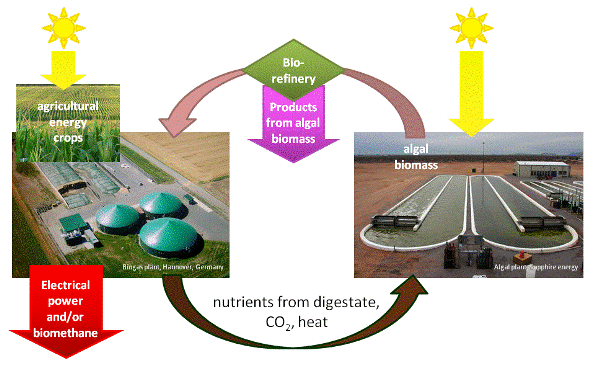Main menu
You are here
The project
Wir bedauern die deutschen Seiten sind nicht verfügbar am dieses zeit.

Algaebiogas project is focused to market introduction of algal-bacterial treatment of biogas digestate, an innovative technology which has significant economic and environmental benefits to biogas operators.
By using algae we can recycle CO2 emissions and mineral nutrients contained in the biogas digestate. Excess heat can also be productively used. Treated digestate is of such quality that it can be reused or safely released to the environment. Resulting biomass can be used as biogas substrate, possibly after extraction of specific components in biorefinery.
Classical biological (bacterial) waste water treatment successfully reduces the quantities of organic substances at the cost of significant CO2 emissions and significant energy consumption for aeration. Mineral nutrients, flushed with the liquid phase of digestate, are lost in the bacterial sludge which is frequently deposited, incinerated or discharged to the environment.
Algae hold a great potential because of their high growth rate, easy production, better utilization of sunlight compared to conventional plants, shorter lifecycles and independence from fertile agricultural land. Biogas plants are rich sources of mineral nutrients, CO2 and heat. By algal recycling we can close material cycles, provide feedstock for bio-refining various higher value products and decrease competition between biogas and food use of agricultural crops.
Within the ECOinnovation project we are setting-up the first application as a demonstration centre and prepare all prefabricated technology, organization and marketing tools to market replication projects. The technology demonstration centre will not only be able to demonstrate the technology in full size at a demanding customers site, but also provide on-site support for customer’s testing, analysis, evaluation, training and other activities required as part of a complex project.
The algaebiogas demonstration centre is being established and operated at one of the project partners site and will demonstrate the technology in different working regimes, measure the operating characteristics of the system, measure environment impacts, provide the LCA data in a realistic set-up and show the installation to the potential customers to enable repeated installations.
Project has already been supported by several important players on EU biogas landscape. It is expected that further marketing and implementation partners will join the initiative during the project.
Environmental impacts of the technology include recycling of nutrients and CO2. The technology aims at complete recycling of nutrients that would otherwise be removed by liquid digestate, recycling of 10-15% of CO2 emitted by a biogas plant and reducing the emissions of CO2 for further 10% in wastewater treatment. In this process approximately 4% of biogas substrate will be replaced by algal biomass and further 4% of cellulose rich substrate would be used, thus reducing needs for energy crops for 8%.




